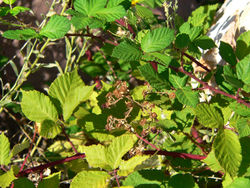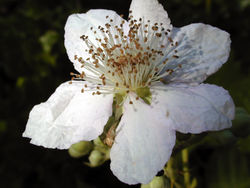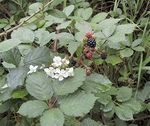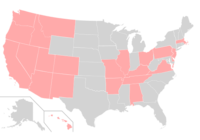Himalayan blackberry
| Himalayan blackberry |
|---|

|
| Scientific Classification |
|
| Scientific Name |
|
Rubus armeniacus |
| The flower of a Himalayan Blackberry |
The Himalayan Blackberry is a species of blackberry that is known by its scientific name Rubus armeniacus. They are perhaps best known as an invasive species that can be found widely in U.S. states, and other countries. But invasive species is also famous for its delicious blackberries. It is used widely in many recipes for pies, tarts, crumbles, and many more dishes.[2]The berries are also a great source of nutrients. They can contain a wide variety of vitamins such as Vitamins C, K, E, B, and A.[2]They also provide a wide variety of minerals such as manganese, copper, magnesium, potassium, and many other minerals.[2] Not only can we eat Himalayan Blackberries, but animals such as bears, birds, foxes, squirrels, and other animals can eat Himalayan Blackberries.
Unfortunately, this plant can cause some problems in our environment. Himalayan Blackberries are what is also known as an aggressive invasive species, which means this plant can impose a threat to our community. They have the power to instantly change an environment. It can grow rapidly, and block out the sun for plants that need sunlight in order to grow, or it can out-grow native plants. [2] It can also block out some animals in the area and prevent them from reaching their environment. Himalayan Blackberry thorns can hurt or trap other animals in the area.[2] So even though it is a beautiful and healthy plant for us, we must keep in mind that this plant can also be a threat to our community.
Body Design
The Himalayan blackberry is a very unique plant that has spread all the way across the United States, although some states don’t have it as prominent as others. It is a very “noxious” weed because it has many little thorns on it that can easily pierce your skin and are very sharp. The plants themselves are arching and very woody. They can vary from a shade of light green to dark green with red spots around the thorns. The canes can grow up to 40 feet and the canes grow biennial although the flowers do not. [3]
The Flowers or reproductive part of the plant Is a white flower with hints of pink depending on the time you see the plant and how far into reproducing the plant is. Each flower has 5 petals somewhat like the leaves on the canes, for they as well have 5 leaves. The Himalayan blackberry produces blackberries much the name implies, and these berries are highly edible and picked by many berry pickers. They are also a food source to other wildlife such as birds, rats, and other small creatures. And because these small animals eat these seeds they help spread them as well, that is on reason why they are so hard to contain. It takes 2 years of devoted effort to get rid of a single cluster of Himalayan Blackberry.[4]
Life Cycle
The life cycle of a Himalaya blackberry. The Himalayan blackberry reproduces by a seed and then vegetatively by roots at the stems tips, after it does that it sprouts from the root buds. The flower part of the Himalayan blackberry doesn’t start growing until spring. Around mid-summer August they start ripening. In winter the temperature drops and they start to die, but the seeds stay viable in the soil for several years.As springs around the seeds start to flower and continue the cycle in a continuous cycle. [5][6][7]
Ecology
The Himalayan Blackberry is mostly native in Western Europe. Though it is called the "Himalayan" Blackberry, there is no evidence of it having grown in the Himalayas. It was thought to make its way there as a cultivated crop.[8] Its other species, rubus discolor, might have been introduced to North America as a cultivated crop in 1885. [8] The locations of Himalayan Blackberries can be found in the following picture on the right.
Himalayan Blackberries infest areas that are mostly disturbed and along streams as well.[9] They can also grow on unmanaged sites and open ground as well.[9] When grown in wet soil, the blackberries end up being more robust and dense.[9] Birds can also distribute the seeds of the Himalayan Blackberry by consuming the blackberries, which contain the seeds. They then transport the seeds to their destination, and plant the seeds by their feces. Because of this, Himalayan Blackberries can also grow in perched sites. Spots underneath power lines and fence rows where birds tend to land are examples of these perched sites.[9]
Himalayan Blackberries can mainly grow in areas with average rainfalls greater than 76 centimetres. It also grows in areas with an altitude of at least 1800 meters. Although Himalayan Blackberries grow in wet, moist soil, it can also grow in soils that are both acidic and alkaline, though they prefer to grow in wet sites at wet climates more, such as creek gullies and river flats. [8] Himalayan Blackberries can grow in temperatures as low as -18 degrees Celsius, and temperatures as high as 37 degrees Celsius.[10]
The Himalayan Blackberry can also act as a food source to many other organisms. Native Americans, for example, ate Himalayan Blackberries as a main food source. They not only ate Himalayan Blackberries, but other berries from the same genus (rubus) as well, such as Rubus spectabilis, Rubus parviflorus, Rubus ursinus, and Rubus leucodermis.[11] Birds can also eat the blackberries and the seeds, aiding in the transportation of the seeds to other locations where they can be grown.[10]
Invasive Species
Location and Method of Introduction
The Himalayan Blackberry was first introduced to the U.S. by Germany, when it was first cultivated in 1885. It was later introduced to the U.S. fifty years later by Luther Burbank, a botanist, who gave this plant its current name thinking it originated from Asia. It then somehow escaped cultivation, and very soon was rapidly spread throughout nearly half of all the fifty states.[12] Some locations in the U.S. include Washington, Oregon, Idaho, California, Nevada, Utah, Montana, Colorado, New Mexico, Arizona, Missouri, Arkansas, Illinois, Alabama, and many more as seen in the picture to the right of Ecology.
Environmental Impact
Himalayan blackberry competes with the native vegetation. It prevents the establishment of native trees that require sun for germination. It blocks the access of large wild life to water and other resources. It blocks access along rivers and wet land edges. In King County it covers lots of area. It is the most invasive species in Seattle's forests.[13]
Control Methods
The Himalayan blackberry is a very common plant that occurs in the northwest and continues to occur, whether it be in your backyard, along the highway or on the edge of a forest. Although it may look pretty and bear delicious blackberries it is a very torturous and noxious plant. It is noxious because of its many thorns that cling to the plants stalks and can easily penetrate thin clothing and can hurt or scratch the one trying to remove the plant. Yet there are a few different ways to get rid of this noxious weed. There are two factors that you do to the plant to remove it, first people usually remove, cut, burn, or poison the outer vegetation then usually destroy, burn, poison, or just remove the root crowns from the ground so that the plant can no longer grow from the roots. A few other methods of destroying the bush or cluster: • Cutting or removing the plant in its early days. • Treating freshly cut stumps with appropriate concentrated herbicide. • Uncut Himalayan Blackberry can be effectively treated in late summer or fall with a broadcast application of a variety of herbicides including triclopyr (i.e. Garlon 3a and 4) and/or glyphosate (i.e. Round-up and similar products) or 2-4D combined with triclopyr (i.e. Crossbow). Although effective control can be achieved by this method. Yet the extensive, standing, dry and hard canes then still need to be removed to allow access for effective restoration. • You could also control it be means of mechanical methods, although very effective it is also very expensive to purchase or rent a machine that would fit your needs to remove the plant.[14]
Video
The person in this video tells us about the clear distinctions and facts of a Himalayan Blackberry.
References
- ↑ Rubus armeniacus Himalayan blackberry United States Department of Agriculture. Web. Accessed November 13, 2017. Unknown Author.
- ↑ 2.0 2.1 2.2 2.3 2.4 Crampton, Linda. Himalayan Blackberry Plants: Invasive, Noxius, and Beautiful Owlcation. Web. Last Modified October 11, 2017.
- ↑ Natural Resources Conservation Service. Plant Guide, HIMALAYAN BLACKBERRY United States Department Of Agriculture. Web. Last Edited: Jan 8th, 2014.
- ↑ Jefferson County Noxious Weed Control Board. fact sheet, Blackberries Jefferson County Washington. Web. November 7th, 2017(date of visitation).
- ↑ King County. Blackberry identification and control King County. Web. September 29, 2017.
- ↑ Authorlastname,FirstnameHimalayan Blackberry Species Natural History. Web. October 22, 2013.
- ↑ Lundman, Susan. Growth Stages for the Blackberry Plant SFGate. Web. Month Day, Year.
- ↑ 8.0 8.1 8.2 Hoshovsky, Marc. Rubus armeniacus Bugwood Wiki. Web. Last modified October 25, 2017.
- ↑ 9.0 9.1 9.2 9.3 BMP: HIMALAYAN BLACKBERRY (Rubus bifrons) Weed Wise. Web. Accessed on November 4, 2017. Unknown Author.
- ↑ 10.0 10.1 Rubus armeniacus (Himalayan blackberry) Invasive Species Compendium. Web. Last Modified June 22, 2017. Unknown Author.
- ↑ Jacobson, Arthur. Himalaya Blackberry; Rubus armeniacus Focke = Rubus discolor Weihe & Nees = Rubus procerus P.J. Muell. Rose Family; ROSACEÆ Himalayan Blackberry by Arthur Lee Jacobson. Web. Accessed on November 4, 2017.
- ↑ Sheina. Species: Himalayan blackberry (Rubus armeniacus Focke) Invasivore. Web. Published February 7, 2011.
- ↑ Blackberry identification and control King County.gov. Web. Date accessed 11 December 2017.
- ↑ Soll, Jonathan. [http://https://www.invasive.org/gist/moredocs/rubarm01.pdf Controlling Himalayan Blackberry (Rubus armeniacus [R. discolor, R. procerus]) in the Pacific Northwest] The Nature Conservancy . Web. March 30, 2004.



